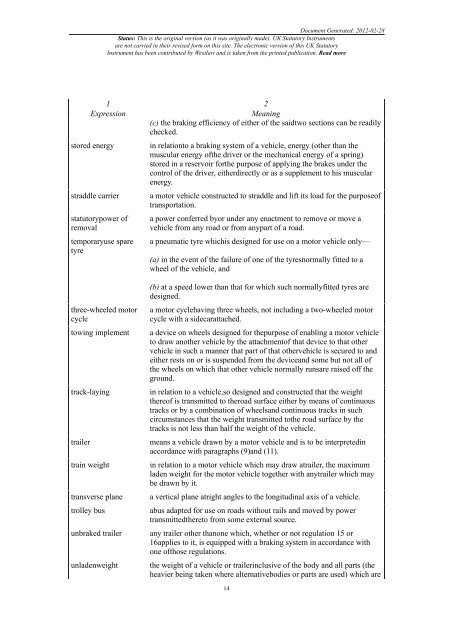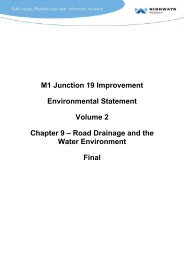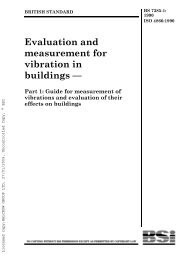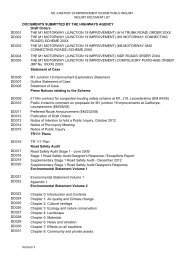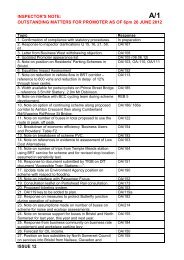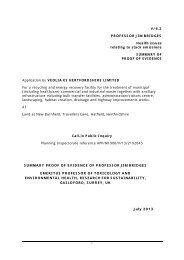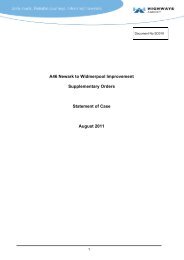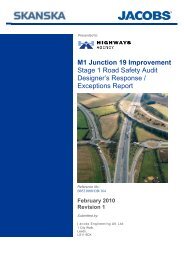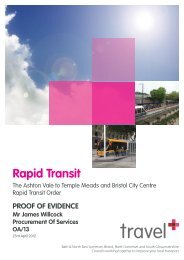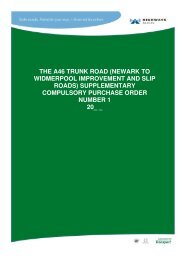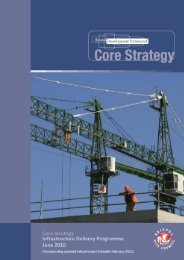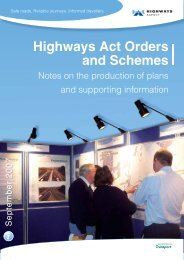The Road Vehicles (Construction and Use) Regulations 1986
The Road Vehicles (Construction and Use) Regulations 1986
The Road Vehicles (Construction and Use) Regulations 1986
You also want an ePaper? Increase the reach of your titles
YUMPU automatically turns print PDFs into web optimized ePapers that Google loves.
Document Generated: 2012-02-28<br />
Status: This is the original version (as it was originally made). UK Statutory Instruments<br />
are not carried in their revised form on this site. <strong>The</strong> electronic version of this UK Statutory<br />
Instrument has been contributed by Westlaw <strong>and</strong> is taken from the printed publication. Read more<br />
1 2<br />
Expression<br />
Meaning<br />
(c) the braking efficiency of either of the saidtwo sections can be readily<br />
checked.<br />
stored energy<br />
straddle carrier<br />
statutorypower of<br />
removal<br />
temporaryuse spare<br />
tyre<br />
in relationto a braking system of a vehicle, energy (other than the<br />
muscular energy ofthe driver or the mechanical energy of a spring)<br />
stored in a reservoir forthe purpose of applying the brakes under the<br />
control of the driver, eitherdirectly or as a supplement to his muscular<br />
energy.<br />
a motor vehicle constructed to straddle <strong>and</strong> lift its load for the purposeof<br />
transportation.<br />
a power conferred byor under any enactment to remove or move a<br />
vehicle from any road or from anypart of a road.<br />
a pneumatic tyre whichis designed for use on a motor vehicle only—<br />
(a) in the event of the failure of one of the tyresnormally fitted to a<br />
wheel of the vehicle, <strong>and</strong><br />
three-wheeled motor<br />
cycle<br />
towing implement<br />
track-laying<br />
trailer<br />
train weight<br />
transverse plane<br />
trolley bus<br />
unbraked trailer<br />
unladenweight<br />
(b) at a speed lower than that for which such normallyfitted tyres are<br />
designed.<br />
a motor cyclehaving three wheels, not including a two-wheeled motor<br />
cycle with a sidecarattached.<br />
a device on wheels designed for thepurpose of enabling a motor vehicle<br />
to draw another vehicle by the attachmentof that device to that other<br />
vehicle in such a manner that part of that othervehicle is secured to <strong>and</strong><br />
either rests on or is suspended from the device<strong>and</strong> some but not all of<br />
the wheels on which that other vehicle normally runsare raised off the<br />
ground.<br />
in relation to a vehicle,so designed <strong>and</strong> constructed that the weight<br />
thereof is transmitted to theroad surface either by means of continuous<br />
tracks or by a combination of wheels<strong>and</strong> continuous tracks in such<br />
circumstances that the weight transmitted tothe road surface by the<br />
tracks is not less than half the weight of the vehicle.<br />
means a vehicle drawn by a motor vehicle <strong>and</strong> is to be interpretedin<br />
accordance with paragraphs (9)<strong>and</strong> (11).<br />
in relation to a motor vehicle which may draw atrailer, the maximum<br />
laden weight for the motor vehicle together with anytrailer which may<br />
be drawn by it.<br />
a vertical plane atright angles to the longitudinal axis of a vehicle.<br />
abus adapted for use on roads without rails <strong>and</strong> moved by power<br />
transmittedthereto from some external source.<br />
any trailer other thanone which, whether or not regulation 15 or<br />
16applies to it, is equipped with a braking system in accordance with<br />
one ofthose regulations.<br />
the weight of a vehicle or trailerinclusive of the body <strong>and</strong> all parts (the<br />
heavier being taken where alternativebodies or parts are used) which are<br />
14


